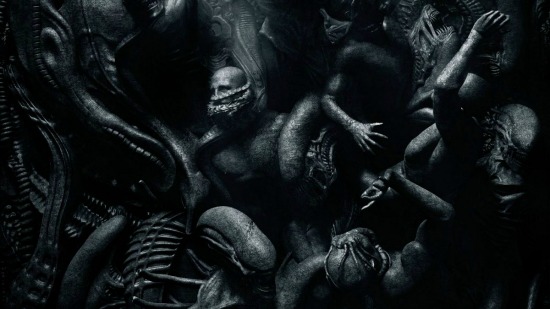There’s no doubt that Ridley Scott’s 2012 Prometheus was a disappointment for fans hoping for a return to form for the Alien series. But for all its faults, Prometheus did one thing right in understanding that the power of the alien lies not in its animal hostility, but as a conduit for existential terror – something that even James Cameron’s superlative Aliens never really got to grips with. The psychosexual qualities of HR Giger’s iconic design are well documented: the alien’s phallic head; Kane’s symbolic rape; its mouth that resembles the vagina dentata. The creature’s ability to adapt, resembling both its hosts and its mechanical environment, are also fundamental to the horror of the creature, far more than its ferocity as a killing machine.
So it’s significant that Prometheus is the only film since the original that depicts the alien – in its embryonic form as the black goo – as more than just a dangerous animal. And for all its unexplained properties, the mystery of the black goo is directly connected to the most enduring mystery of the series: the long dead pilot of Alien’s derelict spacecraft. Although Prometheus insists that the engineers’ exoskeleton is a suit, one need only look at the giant creature in Alien to see that its calcified body is made of bones, not breathing apparatus. Moreover, its ribs closely resemble the fingers of the facehugger, hinting at a radically different vision of the alien life cycle from the sequels.
A deleted scene, reinstated in the 2003 director’s cut, goes further by suggesting that the alien’s victims are transformed into eggs: at the end of the film, Ripley finds a still alive and cocooned Captain Dallas. As he begs Ripley to kill him, she sees another cocooned figure, Brett. He is turning into an egg – referred to as "egg-morphing" by the fans – begging the question of the origin of the eggs on the derelict. So when Lambert asks "I wonder what happened to the rest of the crew" of the derelict alien ship, it’s implied that they have suffered a similar fate, further implied by the facehuggers’ resemblance to the derelict’s pilot.
This reading of the xenomorph contradicts the concept of the queen alien in the later films, but it also enriches our interpretation of Scott’s creature. The crew encounter a being that is at once truly alien but paradoxically familiar, adopting the features not only of its host-parent, but also of its mechanical surroundings. Taken in isolation, Alien’s vision of the xenomorph as a terrible child is far more disquieting and thematically potent than the space-insects of the sequels. The monster doesn’t just kill, it assimilates its victims in a twisted sexual partnership, penetrating and implanting itself inside them. Its birth is a monstrous, phallic eruption, a manifestation of the crew’s subconscious sexual anxieties, conjured by Parker’s lewd joke – the last words spoken before Kane succumbs – about "eating" Lambert.
The creature transgresses the boundaries between species and in doing so, gives the film’s title a monstrous irony. This brings us to Alien’s own monstrous child, Prometheus. Rightly derided as a baffling mess, Scott’s ambitious prequel nevertheless attempts to rehabilitate the alien as a locus of existential horror, reconstituted as the black goo. As a narrative device, it’s a disaster – the goo’s inconsistent properties variously dissolve engineers into DNA, turn astronauts into zombies, create vagina-cobras, and impregnate women with squid monsters. Its apparent ability to do anything is dramatically frustrating, but the goo’s conceptual qualities – its formlessness and ability to monstrously transform people on contact – speak directly to the elemental power of the xenomorph as originally envisioned by HR Giger.
Just as the creature itself is transformed, so too is Alien’s concept of the monstrous child, refigured in Prometheus as a recurring motif of parental rejection. This is most potent in the famous abortion sequence with Shaw; not only is it the best scene in the film, but also a legitimately visceral moment of body horror. The theme is botched with that nonsense about Vickers being Weyland’s daughter, but its potential still resonates with Alien’s core themes.
So what does all this mean for Alien: Covenant? The body horror hinted at in the trailers suggests a return to Alien’s roots, but we must remember that Prometheus’ marketing made similar promises. And if, as some have speculated, David has been experimenting on Shaw to create the xenomorph, it’s disappointing that the creature is no longer a natural phenomenon. Part of what made Alien so frightening was that nature, in all its indifferent variation, was capable of producing such a nightmare. The power of that nightmare is somewhat diminished if it’s just been grown in a laboratory.
Alien: Covenant will likely tell a more coherent and compelling story than Prometheus, and reintroducing the eponymous monster in all its ferocious glory is a sure fire way to win round audiences. The measure of monstrosity, however, is not in ferocity, but transgression: at its most powerful, the xenomorph transgresses boundaries between parasite and host, parent and sexual partner, human and alien. The monster is abject, but in blurring the boundaries between us and it, we become partners in that abjection. It is a terrible distortion of ourselves, an embodied abyss staring back at us. The return of the xenomorph is all well and good, but only through a new embodiment of existential terror will Covenant find its voice.


